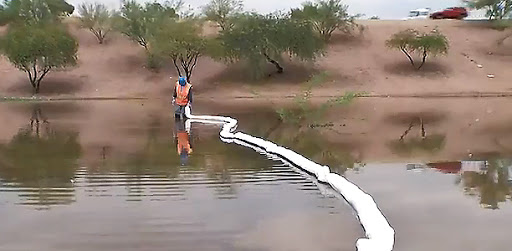ADOT HAZMAT crews play important role in making the road safe
ADOT HAZMAT crews play important role in making the road safe

You already know that ADOT works alongside other emergency response agencies to clear the road after a major incident.
We’ve highlighted those efforts before here on the blog – for a quick refresher, check out the August 24 or September 13 blogs.
However, we have never really touched on the important role ADOT’s HAZMAT specialists play in making the road safe again for drivers.
That’s something we plan to remedy today…
First, let’s define what we’re talking about when we refer to hazardous materials.
According to the U.S. Department of Transportation, hazardous materials are substances that pose an unreasonable threat to the public and the environment (think explosives, flammable liquids, compressed gasses, etc.)
Just because they’re labeled as a hazardous material, doesn’t necessarily mean these things can’t be transported. It does mean that some extra safety regulations must be adhered to by truck drivers and the companies moving these substances (the sheer number of safety considerations deems it too big a topic for just one blog post.
Truck drivers transporting hazardous materials (as classified by law) are required to display a placard on the truck indicating how dangerous the load is.
So, what happens when a truck carrying hazardous materials crashes or turns over on one of the state’s roads?
It’s considered a major incident by ADOT HAZMAT Specialist Travis Qualls, who will typically respond to the scene no matter where it is in the state – Qualls says he sees roughly 20-30 major incidents a year.
During the initial emergency phase DPS HAZMAT agencies are in charge, per state law, but ADOT’s ALERT team and HAZMAT specialists (and other emergency responders) work right alongside the DPS crews.
When responding to a HAZMAT emergency situation, there’s a dual responsibility, according to Qualls.
“Our first thing is life safety – make sure that no one is in harm’s way,” he said. “Once that is taken care of we over see the environmental cleanup. We make sure the responsible parties clean it up.”
After the initial response, ADOT works to make sure the road and surrounding right of way gets cleaned up.
Whoever is responsible for the incident has to pay for the cleanup. Qualls works with the hired contractors to follow up and make sure the hazardous materials are removed. Depending on the type of incident, ADOT may need to issue permits for further cleanup days after the crash/spill.
How the ensuing cleanup proceeds hinges on a number of factors...
“It all depends on the situation. If the hazardous materials make it into the soil, it’s a different story. If it goes into a waterway than it’s a whole different story,” he said.
A recent cleanup, described by Qualls in this video, happened after a produce truck rolled on I-10. He explains in the video that the cleanup contractor hired by the responsible party used booms (big absorbent objects) to drag oil and fuel that had seeped into nearby retention basins down to a vacuum truck. Days later when the basins were dry, the contractors were required to come back to the scene and take soil samples for further testing.
That’s an example of a fairly typical situation, but Qualls says he runs into all sorts of things on the job … from trucks with placarded HAZMAT loads to substances that are abandoned on the side of the road (used motor oil, unknown types of white powder and other materials have to be investigated and handled carefully).
One last thing…
Qualls advises drivers to play it safe when it comes to any materials out on the road. Whether it’s something left on the side of the road or the result of a crash, Qualls says it’s not worth putting your safety in jeopardy. Call 911 and get the proper people responding to the scene.


